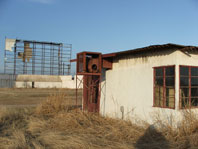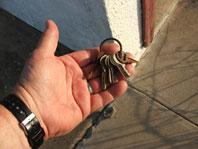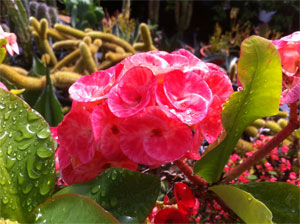Native Son – March, 2011

There’s always room for one more plant in Wyler’s Greenhouse, west of Weatherford. All photos by Steven Chamblee.
Native Plant Road Trip to Wichita Falls
Spring is an amazing time of rebirth … frozen at the start and smothered in blossoms by the end. And, as a 20-year-old A.E. Housman said so eloquently back in 1879, it is precious.
“Loveliest of trees, the cherry now,
Is hung with bloom along the bough,
And stands about the woodland ride,
Wearing white for Eastertide.
“Now, of my threescore years and ten,
Twenty will not come again,
And take from seventy springs a score,
It only leaves me fifty more.
“And since to look at things in bloom,
Fifty springs are little room,
About the woodlands I will go,
To see the cherry hung with snow.”
As for me, I’ve rolled past 50 years, so I’m looking at maybe 20 more … if I’m lucky. (You don’t see many 90-year-old barrel-chested men playing dominoes in the park.) So I’m taking a little time to appreciate spring this year. (Actually, I’m reveling in it, rejoicing in it, and even skinny-dipping in it!) Allons, les amis!

During a visit with Charlie (see below), Eric tries the homemade wagon on for size.
Eric Vanderbeck, a buddy of mine, joined me on a road trip to Wichita Falls this month. Eric works for REAL Schools (acronym for Rainwater Environmental Alliance for Learning), an organization that partners with local schools to promote enhanced educational opportunities by creating outdoor learning environments. I have seen many of these school gardens and personally witnessed the amazing connections made by students when Mother Nature teaches class. (Visit www.realschoolgardens.org for more info.)
All that fancy stuff being said, Eric is, like me, a self-discoverer at heart. Never mind what the book says, we’ve got to try it for ourselves … bull nettle seeds, sweetgum twigs, pokeberries, toothache tree leaves, dandelion greens, redbud flowers, Turk’s cap apples, wild plums and persimmons off the ground … over-educated scavengers, I suppose. Even the grocery store is fair game: quinoa, amaranth seed, pickled quail eggs, Clamato….
On the ride home, we stop to explore an abandoned drive-in, complete with a set of keys lying outside the snack bar, swallows nests inside the old projection booth, and a rusted-out ladder leading to the top of the screen. A few miles later, it’s a tractor graveyard, which includes several with all-steel wheels. Then it is a visit with Charlie, a former merchant marine patiently re-discovering the blue highways of Texas with an old donkey and a hand-hewn cart. What started as a bout of bad luck six years ago has evolved into a pioneer’s quest to discover and learn from this land, quite literally one step at a time.

Fifty years ago, the smell of popcorn filled the air.

Steven peers from the old projection booth.

Still there … Steven replaced the keys after the photo.

Note the “mud biters” on the rear wheels of this old tractor.

The original “Stairway to Heaven.”

A colony of purple-hued henbit.

The delicate blossoms of Texas bluestar (Amsonia ciliata var. texana).

Sumptuous flowers atop crown of thorns (Euphorbia milii)
Dry winter conditions have made the wildflowers sparse, but one love/hate species is booming. Henbit (Lamium amplexicaule) is considered by most Texans to be a short-lived garden nuisance, and quite honestly, I’ll buy that. But I also have to admire this mint family member’s ability to form lovely colonies for a few weeks until it gets melted away by 90-degree heat in late spring. Native to Europe, it is considered a noxious invasive species by some folks. (Hmmm … a few years back, the Beatles, Abba, Yanni, and the Swedish bikini team were described in much the same manner, but somehow we all survived.) I once heard Dotty Woodson say that if some researcher could develop larger henbit flowers, we’d have a real winner on our hands. I think she was right.
A few miles later, a few wisps of pale blue attract my attention, and we stop to check out a patch of Texas Bluestar (Amsonia ciliata var. texana). Delicate little baby blue flowers rest in my hand, as my nose savors the sweet scent of dusting powder. Scant rainfall has kept these plants to about 10 inches; in wet years, I’ve seen this particular patch of native Texas perennials almost twice as tall.
Texas Bluestar is a member of the Dogbane family, also known as Apocynaceae. I can think of no better plant family that demonstrates the Dr. Jekyll/Mr. Hyde nature of plants. Familiar family members include plumeria (the flowers are famous for being strung into Hawaiian leis) and oleander (the flowers are infamous for being poisonous). Following this angel/devil scheme are Catharanthus and Acokanthera, the former being the lovely ornamental periwinkle, which coincidentally contains chemicals being used to treat cancer; the latter provides the toxin for those potent African poison darts … no kidding. The bottom line to this thought is two-fold: know what you are eating and be mindful that dose is everything. Reminds me of the famous mycological saying: “There are old mushrooms hunters, and there are bold mushrooms hunters, but there are no old, bold mushrooms hunters.”
Just west of Weatherford we drop into Wyler’s Nursery to snag some specialty succulents. Every time I come here, I laugh to myself, because if I had a large greenhouse, it would likely look just like this horticultural madhouse. Stacks of succulents, tons of tomatoes, piles of peppers, and a heapin’ helpin’ of everything else packed in, sardine style. If you are a serious Type A, don’t even set foot in the door … it’d probably kill you. For the rest of us, it’s fun to check out and search for true treasures, like that amazing crown of thorns over there, with sumptuous blossoms as big as geranium inflorescences. I’ll come back in a few weeks for the secret inventory blow-out. Shhh … every year, Marion Wyler loses her normal good sense the Saturday after the April 15 tax day and tries to clean out her greenhouse. This year, that will be April 16, and it’s all up for grabs. 3401 FM 1189, Brock, Texas 76087. Cash or local check only. Shhh … just between us.

Indian mustard
As we enter Fort Worth, another love/hate flower is blooming along the freeway. Indian mustard (Brassica juncea), that 3- to 5-foot-tall, pale yellow cloud that appears every spring along roadsides across Texas. Simply spectacular when smothered in dime-sized flower clusters, this tall Eurasian native scores a 10 for billowy beauty, but still gets criticized for being difficult to mow after blooming. I’m sure the folks down at the John Deere shop have a remedy for that.

Late afternoon sun creates larger-than-life Texans.
So Eric finishes his meticulous note-taking, bales out, and trots back to his happy home. I suppose I should head off toward my house now; after all, it’s been a long day. But still, I hate to waste a moment of daylight. This could well be the last time I witness the spectacle of spring. Hmmm … I wonder if the cherry trees are in bloom over at the Fort Worth Japanese Garden?
About the author: Steven Chamblee is the chief horticulturist for Chandor Gardens in Weatherford and a regular contributor to Neil Sperry’s GARDENS magazine and e-gardens newsletter. Steven adds these notes:
Spring is in full swing at Chandor Gardens! Join us for our annual Spring Fling event April 2-3. The gardens are blooming, the house is open for tours, and admission is just $1 — just as it was 50 years ago. For more info, visit www.chandorgardens.com or call 817-613-1700. From the D/FW metroplex, take I-20 west to exit #409, turn right on Santa Fe, go 2.1 miles, turn left on Lee Avenue, go straight 12 blocks and you’re driving in the gate.
I can always use another road trip! Let me know if you’d like me to come out and speak to your group sometime. I’m low-maintenance, flexible, and you know I like to go just about anywhere. No city too big; no town too small. Just send me an e-mail at schamblee@weatherfordtx.gov and we’ll work something out.

